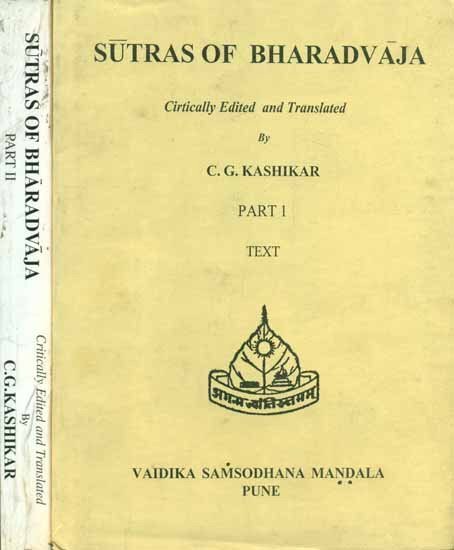Bharadvaja-srauta-sutra
by C. G. Kashikar | 1964 | 166,530 words
The English translation of the Bharadvaja-Srauta-Sutra, representing some of the oldest texts on Hindu rituals and rites of passages, dating to at least the 1st millennium BCE. The term Srautasutra refers to a class of Sanskrit Sutra literature dealing with ceremonies based on the Brahmana divisions of the Veda (Sruti). They include Vedic rituals r...
Praśna 4, Kaṇḍikā 19
1. He should place the veda within the altar,[1] and rub it with the formulas, “Thou art the veda, thoṇ art the gain, may I gain. Thou art action; thou art making; may I make. Thou art winning; thou art the winner; may I win. May the veda give me the abundance of prosperity, rich in ghee, rich in houses, thousandfold, and strong.”[2]
2. Subsequent to the word videya, he should utter the name of whatever he may desire from his enemy.
3. He should follow the Patnīsaṃyāja-offerings[3]—the first with the formula, “By sacrifice to god Soma may I, possessing good seed, impregnate seed;”[4] the second with the formula, “By sacrifice to god Tvaṣṭṛ may I develop the form of cattle.”[4]
4. (The one) to Rākā with the formula, “By the sacrifice to Ṛākā may I become rich in offspring;” (the one) to Sinīvālī with the formula, “By the sacrifice to Sinīvālī may I become rich in cattle;” (the one) to Kuhū with the formula, “By the sacrifice to Kuhū may I become rich in prosperity and cattle.” The sacrificer’s wife should follow (the offerings) to these very three (divinities). (For that purpose) she should modify the formulas.
5. The sacrificer should follow the last two Patnīsaṃyāja offerings (together) with the formula, “The wives of the gods and Agni, the lord of the house, are the pair of sacrifice. By the sacrifice to them may I be propagated with a pair.”[5]
6. He should follow (the invoking of) the Ājyedā[6] with the verse, “May the Iḍā cover us with clarified butter in whose footprints the pairs purify themselves. The Iḍā belonging to all men, mighty, belonging to all gods, has arrived at the sacrifice, growing.”
7. As soon as the chaff of grains has been offered,[7] he should wipe his mouth with the formula, “Sarasvatī is the supporter of the people; may we (O Sarasvatī,) become a part of thine.”
8. After the samiṣṭayajus offering has been made,[8] he should partake of the sacrificer’s portion[9] with the formula, “May the lord of sacrifice be united with the prayer.”[10]
9. If the sacrificer is away on a journey, the Adhvaryu should put the sacrificer’s portion into the Dhruvā, and offer it together with the samiṣṭayajus oblation with the formula, “Prajāpati’s is the world called Vibhān. In it I place thee along with the sacrificer.”[11]
Footnotes and references:
[1]:
III.7.1.
[2]:
Taittirīya-saṃhitā I.6.4.4.
[3]:
III.7.7.
[4]:
Taittirīya-saṃhitā I.6.4.3.4.
[5]:
Taittirīya-saṃhitā I.6.4.4.
[6]:
III.8.15.
[7]:
I.22.12; III.9.5.
[8]:
III.12.1.
[9]:
III.3.3.
[10]:
Taittirīya-saṃhitā I.3.8.1.
[11]:
Taittirīya-saṃhitā I.6.5.1.
